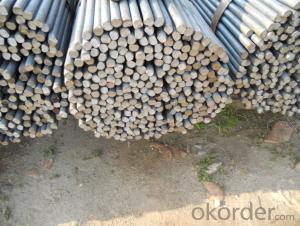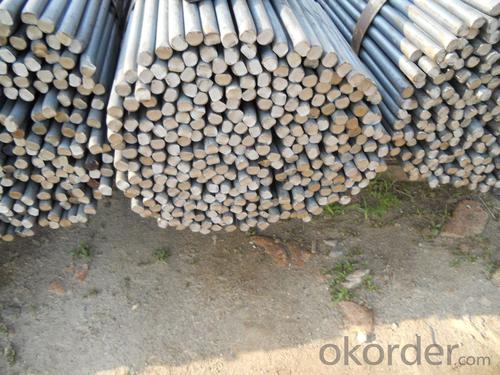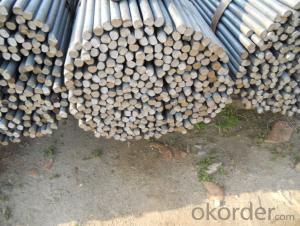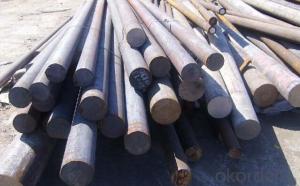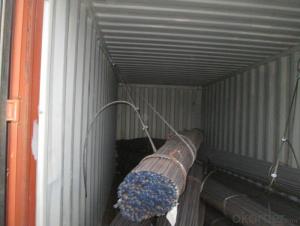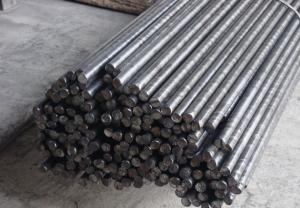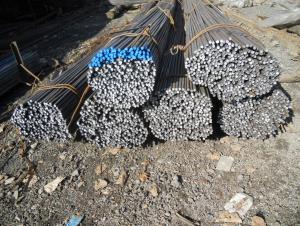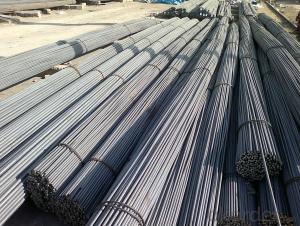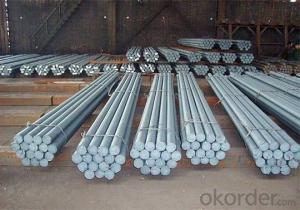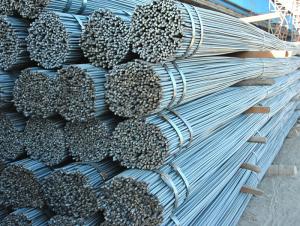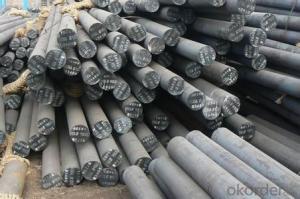Hot Rolled Round Steel Bar High Quality
- Loading Port:
- China Main Port
- Payment Terms:
- TT or LC
- Min Order Qty:
- -
- Supply Capability:
- -
OKorder Service Pledge
OKorder Financial Service
You Might Also Like
Product Description:
OKorder is offering Round Bar at great prices with worldwide shipping. Our supplier is a world-class manufacturer of steel, with our products utilized the world over. OKorder annually supplies products to European, North American and Asian markets. We provide quotations within 24 hours of receiving an inquiry and guarantee competitive prices.
Product Applications:
1. Hot rolled round bar of 6-25mm, or small round is mostly used for straight bundles supply, and used for steel, bolts and various mechanical parts. While the bigger round bar, or more than 25mm hot rolled bar, is mainly for the manufacture of mechanical parts or for seamless steel billet.
2. Besides, we can supply some especial material steel round bar that can be used for main shaft of steamer, hummer shank, with big section and supper force.
Product Advantages:
OKorder's Round Bar are durable, strong, and resist corrosion.
Main Product Features:
· Premium quality
· Prompt delivery & seaworthy packing (30 days after receiving deposit)
· Corrosion resistance
· Can be recycled and reused
· Mill test certification
· Professional Service
· Competitive pricing
Product Specifications:
1. Grade: Q195, Q235, Q345
2. Diameter: 6mm-150mm
3. Length: 6m, 9m, 12m or as customer’s request
4. Tolerance: Within ±5% for weight; ±2mm for diameter
5. Note: The price can be better is the quantity is good
6. Chemical composition
Alloy No | Element (%) | ||||
C | Mn | S | P | Si | |
Q195 | 0.06-0.12 | 0.25 | ≤0.05 | ≤0.045 | ≤0.3 |
Q235 | 0.12—0.20 | 0.3—0.7 | ≤0.045 | ≤0.045 | ≤0.3 |
Q345 | ≤0.2 | 1.00-1.60 | ≤0.045 | ≤0.045 | ≤0.55 |
Mechanical Properties | Grade | Steel diameter(mm) | |||
≤16 | 16~40 | 40~60 | 60~100 | ||
Yield Point Δs/MPa | Q195 | ≥195 | ≥185 | - | - |
Q235 | 235 | 225 | 215 | 205 | |
Tensile Strength | Q195 | 315~390 | |||
Q235 | 375~500 | ||||
Elongation δ5% | Q195 | ≥33 | ≥32 | - | - |
Q235 | 26 | 25 | 24 | 23 | |
Payment:
-Invoicing on theoretical weight or actual weight as customer’s request.
-FOB, CFR or CIF.
-Regular terms of payment:
1, 30% payment in advance, the remaining balance (70% payment) against the copy of B/L.
2, 30% payment in advance, the remaining balance (70% L/C) against the copy of B/L.
3, Negotiable.
-The payment terms will be written in contraction detailed.
FAQ:
Q1: Why buy Materials & Equipment from OKorder.com?
A1: All products offered byOKorder.com are carefully selected from China's most reliable manufacturing enterprises. Through its ISO certifications, OKorder.com adheres to the highest standards and a commitment to supply chain safety and customer satisfaction.
Q2: How do we guarantee the quality of our products?
A2: We have established an advanced quality management system which conducts strict quality tests at every step, from raw materials to the final product. At the same time, we provide extensive follow-up service assurances as required.
Q3: Can stainless steel rust?
A3: Stainless does not "rust" as you think of regular steel rusting with a red oxide on the surface that flakes off. If you see red rust it is probably due to some iron particles that have contaminated the surface of the stainless steel and it is these iron particles that are rusting. Look at the source of the rusting and see if you can remove it from the surface.
Images:
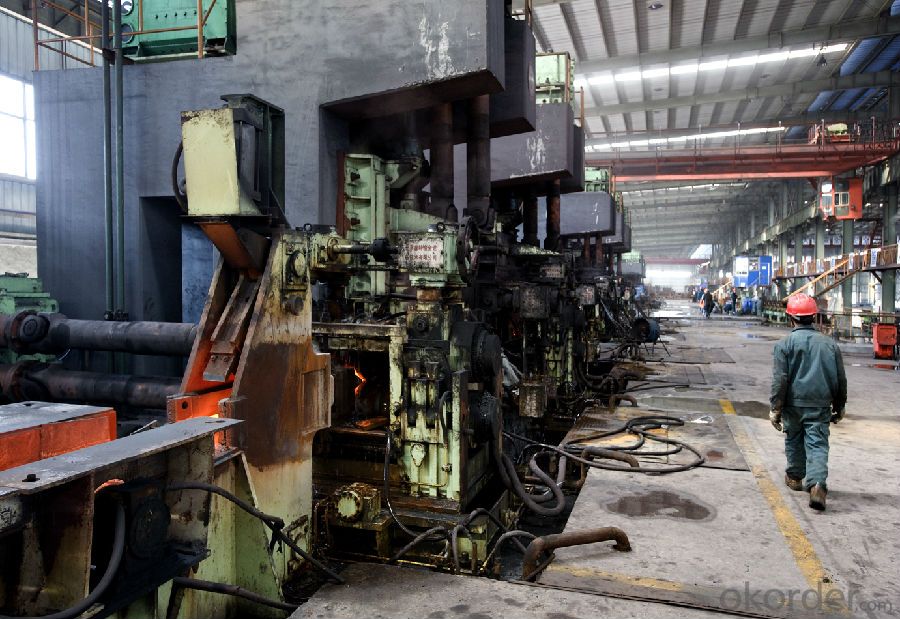

- Q: How are steel round bars used in the manufacturing of heat exchangers?
- Due to their unique properties, steel round bars are commonly utilized in the production of heat exchangers. These devices are responsible for transferring heat between multiple fluids, and the inclusion of steel round bars is essential to their construction. One primary application of steel round bars in heat exchangers is in the manufacturing of the tubes. These tubes are responsible for carrying the fluids that require heating or cooling. Steel round bars are frequently chosen as the base material for these tubes due to their exceptional heat transfer properties and high strength. The round shape of the bars facilitates the easy fabrication of the tubes, ensuring a secure and snug fit. Moreover, steel round bars are utilized in the construction of the headers and tube sheets in heat exchangers. The headers enable the fluid to enter and exit the heat exchanger, while the tube sheets hold the tubes firmly in place. These components must possess durability and high strength to withstand the pressure and temperature differentials encountered during heat exchange. Steel round bars provide the necessary stability and strength to ensure the proper operation of the heat exchanger. Furthermore, steel round bars are also employed in the manufacturing of the support structures or frames of heat exchangers. These structures offer stability and support to the various components of the heat exchanger, ensuring proper alignment and positioning. Steel round bars exhibit excellent structural integrity and can endure heavy loads, making them an ideal choice for this purpose. In summary, steel round bars play a vital role in the production of heat exchangers. Their high strength, excellent heat transfer properties, and durability make them well-suited for fabricating the tubes, headers, tube sheets, and support structures of heat exchangers. By incorporating steel round bars, manufacturers can guarantee the efficiency, effectiveness, and longevity of heat exchangers in numerous industries, including power generation, chemical processing, and HVAC systems.
- Q: What are the advantages of using tool steel round bars?
- Tool steel round bars offer numerous benefits. Firstly, they boast outstanding hardness and wear resistance, making them perfect for high-stress applications like manufacturing cutting tools, dies, and molds. The hardness of tool steel also enables precise machining, resulting in accurate and intricate shapes. Secondly, tool steel round bars possess exceptional toughness and impact resistance, enabling them to withstand heavy-duty applications without breaking or cracking. This makes them suitable for demanding industries such as aerospace, automotive, and construction. Moreover, tool steel round bars are renowned for their high temperature resistance, maintaining their hardness and strength even in extreme heat. This is particularly advantageous in applications exposed to high temperatures, like forging or heat treating operations. Another advantage is the dimensional stability of tool steel round bars. They have a low coefficient of thermal expansion, meaning they undergo minimal dimensional changes when subjected to temperature variations. This ensures reliability and predictability in various operating conditions. Furthermore, tool steel round bars can be easily machined and heat treated to achieve specific properties. This versatility allows manufacturers to tailor the material to their specific needs, enhancing the overall performance of the end product. Additionally, tool steel round bars are readily available and cost-effective. They are widely produced and stocked by suppliers, ensuring easy accessibility for various applications. Furthermore, their longevity and resistance to wear and tear contribute to their cost-effectiveness. In conclusion, the advantages of using tool steel round bars include exceptional hardness, toughness, high temperature resistance, dimensional stability, versatility, availability, and cost-effectiveness. These properties make them the preferred choice in industries where durability, precision, and reliability are paramount.
- Q: What are the different types of heat treatment for steel round bars?
- Steel round bars commonly undergo various heat treatment methods to enhance their mechanical properties and overall performance. These methods include annealing, normalizing, quenching, tempering, and case hardening. 1. Annealing: Steel round bars are heated to a specific temperature and gradually cooled to room temperature. This process reduces internal stresses, improves machinability, and enhances ductility. 2. Normalizing: The steel round bars are heated above the critical range and cooled in still air. Normalizing refines the grain structure and improves mechanical properties like strength and toughness. 3. Quenching: Steel round bars are heated to a high temperature and rapidly cooled by immersing them in a quenching medium such as water, oil, or polymer. This results in a hardened microstructure, increasing hardness and wear resistance. 4. Tempering: After quenching, the steel round bars undergo tempering. The quenched steel is reheated to a specific temperature and cooled in still air. Tempering reduces brittleness caused by quenching, increases toughness, and relieves residual stresses. 5. Case hardening: This process increases the hardness and wear resistance of the outer surface of steel round bars while maintaining a tough and ductile core. Case hardening involves heating the steel in a carbon-rich atmosphere or applying a carbon-rich substance, followed by quenching and tempering. Each heat treatment method has its advantages and is chosen based on the desired properties and applications of the steel round bars. It is crucial to select the appropriate heat treatment process to achieve the desired mechanical properties and performance.
- Q: Are steel round bars suitable for agricultural applications?
- Steel round bars are indeed appropriate for agricultural applications. Due to its robustness and endurance, steel proves to be a resilient material capable of enduring the challenging conditions frequently encountered in agricultural settings. The utilization of steel round bars in agriculture encompasses a multitude of purposes, including the construction of fences, gates, and animal enclosures. Moreover, they are frequently employed in the creation of structures like barns and storage sheds. Furthermore, steel round bars can serve as dependable support beams or posts for agricultural machinery and equipment. The reliability and adaptability of steel render it an excellent choice for agricultural applications.
- Q: What is the difference between a cold-drawn and a centerless ground steel round bar?
- Both cold-drawn and centerless ground steel round bars are distinct types of steel bars that have undergone different manufacturing processes, leading to varied characteristics and properties. To produce cold-drawn steel round bars, a hot-rolled or annealed steel bar is pulled through a die, decreasing its diameter and increasing its length. This procedure enhances the steel's mechanical properties, making it stronger, more precise in dimensions, and possessing a smoother surface finish. Cold-drawn bars exhibit superior tensile strength, improved surface finish, and tighter dimensional tolerances compared to hot-rolled bars. They are frequently employed in applications that necessitate precision and strength, such as automotive components, machinery parts, and construction materials. On the contrary, centerless ground steel round bars are created by passing a cylindrical steel bar through a grinding machine without the need for centers or support. This grinding process eliminates surface imperfections and deviations in diameter, resulting in a precise and smooth finish. Centerless ground bars offer exceptional dimensional accuracy, surface finish, and roundness. They are commonly utilized in applications where precision and tight tolerances are crucial, such as in the production of bearings, shafts, and hydraulic cylinders. In conclusion, the primary distinction between a cold-drawn steel round bar and a centerless ground steel round bar lies in the manufacturing process and the resultant properties. Cold-drawn bars are formed by pulling the steel through a die, leading to enhanced mechanical properties, tighter tolerances, and a smoother surface finish. Centerless ground bars are produced by grinding the steel to enhance dimensional accuracy, roundness, and surface finish. Both types of bars possess their own advantages and are suitable for different applications based on the required precision, strength, and surface finish.
- Q: What is the maximum length of a steel round bar available?
- The maximum length of a steel round bar available can vary depending on various factors such as the manufacturing capabilities, transportation limitations, and customer requirements. However, in general, steel round bars can be produced in lengths ranging from a few feet to several meters. The specific maximum length will depend on the size and diameter of the round bar, as well as other logistical considerations. It is important to consult with steel suppliers or manufacturers to determine the maximum length available for a specific type and size of steel round bar.
- Q: Can steel round bars be used in the oilfield equipment industry?
- Yes, steel round bars can be used in the oilfield equipment industry. Steel round bars are commonly used in the oilfield industry due to their high strength, durability, and resistance to corrosion. They are used to manufacture various components and equipment such as drill collars, drill bits, valves, and pump shafts. The use of steel round bars ensures that the equipment can withstand the harsh conditions and extreme pressures encountered in oilfield operations. Additionally, steel round bars can be easily welded and machined to meet specific requirements, making them a versatile choice for the oilfield industry.
- Q: What are the different types of steel round bar alloys for improved strength?
- There are several different types of steel round bar alloys that are known for their improved strength. These alloys are developed through the addition of various elements to the steel composition, resulting in different properties and strengths. One commonly used alloy for improved strength is carbon steel. This alloy contains a higher carbon content, which enhances its strength and hardness. Carbon steel round bars are widely used in applications that require high strength, such as construction, automotive, and machinery. Another type of alloy is stainless steel, which is known for its corrosion resistance and high strength. Stainless steel round bars are often used in environments where corrosion is a concern, such as marine applications, food processing, and chemical plants. Alloy steel is another category that offers improved strength. This type of steel is created by adding elements such as chromium, molybdenum, and nickel to the composition. Alloy steel round bars are commonly used in industries that require high strength and durability, such as aerospace, oil and gas, and power generation. Tool steel is yet another alloy that provides enhanced strength and toughness. Tool steel round bars are specifically designed for machining and cutting applications, where high wear resistance and hardness are crucial. Lastly, there are specialty alloys such as nickel alloy and titanium alloy round bars, which offer exceptional strength and unique properties for specific applications. Nickel alloy round bars are often used in industries such as aerospace, chemical, and nuclear, while titanium alloy round bars are commonly found in aerospace, medical, and automotive industries. In conclusion, the different types of steel round bar alloys for improved strength include carbon steel, stainless steel, alloy steel, tool steel, and specialty alloys. Each of these alloys has its own unique properties and applications, providing a wide range of options for industries that require high strength materials.
- Q: Can steel round bars be used for making body panels?
- Yes, steel round bars can be used for making body panels. Steel is a commonly used material in the automotive industry due to its strength, durability, and formability. Round bars can be shaped, welded, and formed into various body panel shapes, providing structural support and protection. However, it's important to note that steel round bars might not be the ideal choice for all body panels, as they can be heavier compared to alternative materials such as aluminum or carbon fiber. The decision to use steel round bars for body panels depends on factors such as the specific vehicle application, desired weight reduction, and cost considerations.
- Q: What are the different types of steel round bar alloys for improved wear resistance?
- Some common types of steel round bar alloys that are known for improved wear resistance include tool steels, stainless steels, and alloy steels. These alloys are specifically designed to withstand wear and abrasion, making them suitable for various applications such as cutting tools, machinery components, and automotive parts.
Send your message to us
Hot Rolled Round Steel Bar High Quality
- Loading Port:
- China Main Port
- Payment Terms:
- TT or LC
- Min Order Qty:
- -
- Supply Capability:
- -
OKorder Service Pledge
OKorder Financial Service
Similar products
Hot products
Hot Searches
Related keywords
